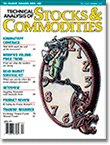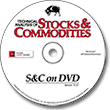Letters To The Editor
June 2010 Letters To The Editor
The editors of S&C invite readers to submit their opinions and information on subjects relating to technical analysis and this magazine. This column is our means of communication with our readers. Is there something you would like to know more (or less) about? Tell us about it. Without a source of new ideas and subjects coming from our readers, this magazine would not exist.
Address your correspondence to: Editor, Stocks & Commodities, 4757 California Ave. SW, Seattle, WA 98116-4499, or E-mail to editor@traders.com. All letters become the property of Technical Analysis, Inc. Letter-writers must include their full name and address for verification. Letters may be edited for length or clarity. The opinions expressed in this column do not necessarily represent those of the magazine. —Editor
Schaff trend cycle indicator
 Editor,
Editor,
In his interesting article in the April 2010 S&C (At The Close: “The Schaff Trend Cycle”), Brian Twomey looked at the Schaff trend cycle indicator (Stc), which applies market cycles to the Macd, resulting in an efficient banded indicator.
While I’ve used Stc since Doug Schaff released the code in 2008, a simple change seems to increase the reliability of the indicator. If the Macd signal line is replaced by the Trix (triple exponential smoothing oscillator), while the indicator looks similar, it signals trends earlier and sticks with a trend longer. To distinguish between the two, I call this indicator the Trix trend cycle (Ttc).
To retain the rest of the TradeStation code from page 96 of the April issue (sidebar, “Schaff trend cycle EasyLanguage code”), the change is to replace the lines:
{Calculate a MACD Line}
XMAC=MACD(c,MA1,MA2);
with:
{Calculate Trix}
XMAC=Trix((h+l+c)/3, MA1);
MA2 is not used. Note also the suggested use of the typical price rather than the close, since, other than on weekly and longer charts, the close of a bar has no real significance in forex.
—David Gianelly
Victoria, Australia
Great online article
Editor,
“The Chartist” by Gary Goldberg, posted at your website at www.premium.working-money.com, is a really great article on Gann’s square of nine. It was clear and easy to understand. Rather than obscuring Gann analysis in esoterica, the article presented mathematically valid explanations for Gann’s “mystical” parabolic calculator. Thank you for the insight.
—B. Chang
Technical articles
Editor,
As someone who has read your magazine back to its very start, I would like to vote against more simplified articles as proposed by one of your other readers (Letters to S&C, April 2010). Technical analysis is by its nature “technical.” There are many publications that cover simplified approaches to market trading, but you publish the only magazine that covers in-depth technical analysis of stocks, options, commodities, and the market.
Please continue to provide the quality, detailed articles that you have in the past.
—Joe Nemecek
Three rules, one easy way to trade ETFs
Editor,
I liked the article “Three Rules, One Easy Way To Trade Etfs” by Larry Connors and David Penn in the January 2009 issue of Stocks & Commodities, but I’m confused about how to count the days: Where do I start counting “day 1”?
—Helen Chen
Based on the three rules presented in the article, say you see an Etf close above its 200-day moving average (rule 1). You are trying to decide when to enter the trade. You’ll have to determine if it closed at a seven-day low (rule 2). Essentially, you’ll have to count backwards. If it closed at a seven-day low, you buy at the close. If not, then you wait for the next day and count backward again. You then exit your position if the Etf closes at its seven-day high (rule 3). For this too, you’ll have to count backward.—Editor
Kondratieff wave and natural gas
Editor,
I enjoyed Koos van der Merwe’s recent article on the Kondratieff wave (“Kondratieff Wave Comeback,” April 2010 S&C). I have followed it loosely for about 40 years. I would appreciate getting his outlook for usages and prices going forward for natural gas — a plentiful asset, not being used to its potential. Any comments would be appreciated as I have been involved with the Etf Ung not realizing it was trading the commodity, not invested in natural gas stocks.
—Bob Hylard
Koos van der Merwe replies:
It is true there is a great deal of natural gas around, and as technology improves, its use becomes more efficient. Since it is so readily available, I cannot see natural gas tying in with the K-wave cycle. It does not influence a currency, and hence, the economy.
It does provide a cheap source of energy, but getting the product to the user is costly. One could argue that cheap energy helps the economy, but to what extent?
Natural gas has always perturbed me because it is methane, and methane is a by-product of coal that has killed many miners, hence “the canary in the cage.” This was always off-putting to me. And a look at Ung falling from a high of $64-odd in July 2008 to a value of $7.01 as I write this seems to justify my thought.
By the way, looking at the chart (daily), I would not be a seller (as I write this at the end of March 2010). As the market starts regaining investor confidence, it should start rising, but it may take a long time, and still, I find it difficult to see the Etf going back up to $64.
K-wave count
Editor,
I read “Kondratieff Wave Comeback” by Koos van der Merwe in the April 2010 S&C. Merwe mentions in the article that we are already in a wave II. However, with the S&P moving above wave I, wave II has not yet started.
Has there been any change in his wave counts since the article was published? If so, what are the new wave counts?
—Mayur Shah
India
Koos van der Merwe replies:
In my article (on page 15 of the April 2010 issue), I wrote, “Figure 1 suggests that the S&P 500 is currently in a wave I up. This is confirmed by the relative strength index (Rsi).”
This means that we are not yet in a wave II down, but that we are still in a wave I up. However, wave 1s are followed by wave 2s down, so a market correction is due for sometime in the future. At the moment, as I write this on April 5, my charts are suggesting that the S&P 500 is completing a wave 4 of wave I. This means that wave 5 of wave I is still ahead of us. When this is complete, only then will wave II down start.
Hope this answers your query.
Formula input
Editor,
How do I input the formulas that are presented in the magazines? Do I need a special program or do I use the C prompt? I have Microsoft XP that I run on a real AT.
—Andrew Guyton
You would likely need a specialized program such as Matlab to make use of the equations and mathematical formulas given in some articles, which are provided mainly for visual inspection to help communicate the logic behind a concept or to define an indicator. They could also possibly be used in Excel if the reader is able to translate the mathematical formulas into Excel spreadsheet format.
Some readers are probably able to translate the mathematical formulas into programming language for their technical analysis program.
As for programming code presented in the magazine (which some software developers refer to as “formulas”), most of the code is for a specific technical analysis program. The name of the program that the code is written for, or the name of the programming language, is always given somewhere near the code or in the article. We occasionally present formulas for use in Microsoft Excel in sidebars to articles.
I hope this answers your question.—Editor
Traders’ tips for bullcharts?
Editor, I subscribe to your mag and like many of the articles, but in your Traders’ Tips section, there is nothing for the software from BullCharts.
BullCharts is very popular trading software here in Australia. (I am speaking of www.bullcharts.com.au, not www.bullcharts.com or www.bullchart.com, which is a different product.)
Is there a way a Traders’ Tip could be offered for this software, since I don’t know how to program the code given for the other programs into BullCharts?
—Tony Sheedy
Code provided in our Traders’ Tips section is provided by the technical analysis software developers themselves — we don’t write the code. Thus, we can’t offer it if they don’t provide it. We suggest contacting their support department directly for the code you seek, and they may be able to provide it.—Editor
S&C on DVD
 Editor,
Editor,
Is your S&C on Dvd product (your fully indexed compilation of S&C articles on Dvd) compatible with Windows 7?
—Javier Muñoz
Yes, the latest version of our S&C on Dvd is compatible with Windows 7.
Readers can call 800-Technical or visit our website at Traders.com for more information or to order.—Editor